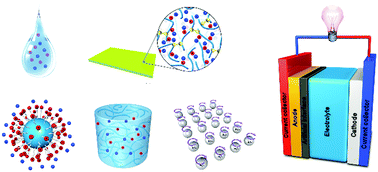当前位置:
X-MOL 学术
›
Chem. Soc. Rev.
›
论文详情
Our official English website, www.x-mol.net, welcomes your
feedback! (Note: you will need to create a separate account there.)
Ionic liquids and derived materials for lithium and sodium batteries
Chemical Society Reviews ( IF 40.4 ) Pub Date : 2018-02-02 00:00:00 , DOI: 10.1039/c7cs00464h Qiwei Yang 1, 2, 3, 4, 5 , Zhaoqiang Zhang 1, 2, 3, 4, 5 , Xiao-Guang Sun 6, 7, 8, 9 , Yong-Sheng Hu 10, 11, 12, 13, 14 , Huabin Xing 1, 2, 3, 4, 5 , Sheng Dai 6, 7, 8, 9, 15
Chemical Society Reviews ( IF 40.4 ) Pub Date : 2018-02-02 00:00:00 , DOI: 10.1039/c7cs00464h Qiwei Yang 1, 2, 3, 4, 5 , Zhaoqiang Zhang 1, 2, 3, 4, 5 , Xiao-Guang Sun 6, 7, 8, 9 , Yong-Sheng Hu 10, 11, 12, 13, 14 , Huabin Xing 1, 2, 3, 4, 5 , Sheng Dai 6, 7, 8, 9, 15
Affiliation

|
The ever-growing demand for advanced energy storage devices in portable electronics, electric vehicles and large scale power grids has triggered intensive research efforts over the past decade on lithium and sodium batteries. The key to improve their electrochemical performance and enhance the service safety lies in the development of advanced electrode, electrolyte, and auxiliary materials. Ionic liquids (ILs) are liquids consisting entirely of ions near room temperature, and are characterized by many unique properties such as ultralow volatility, high ionic conductivity, good thermal stability, low flammability, a wide electrochemical window, and tunable polarity and basicity/acidity. These properties create the possibilities of designing batteries with excellent safety, high energy/power density and long-term stability, and also provide better ways to synthesize known materials. IL-derived materials, such as poly(ionic liquids), ionogels and IL-tethered nanoparticles, retain most of the characteristics of ILs while being endowed with other favourable features, and thus they have received a great deal of attention as well. This review provides a comprehensive review of the various applications of ILs and derived materials in lithium and sodium batteries including Li/Na-ion, dual-ion, Li/Na–S and Li/Na–air (O2) batteries, with a particular emphasis on recent advances in the literature. Their unique characteristics enable them to serve as advanced resources, medium, or ingredient for almost all the components of batteries, including electrodes, liquid electrolytes, solid electrolytes, artificial solid–electrolyte interphases, and current collectors. Some thoughts on the emerging challenges and opportunities are also presented in this review for further development.
中文翻译:

锂和钠电池的离子液体和衍生材料
在便携式电子产品,电动汽车和大型电网中,对高级能量存储设备的需求不断增长,这引发了过去十年来对锂和钠电池的深入研究。改善其电化学性能并提高使用安全性的关键在于开发先进的电极,电解质和辅助材料。离子液体(ILs)是在室温附近完全由离子组成的液体,其特点是具有许多独特的特性,例如超低挥发性,高离子电导率,良好的热稳定性,低易燃性,宽的电化学窗口以及可调节的极性和碱性/酸度。这些特性为设计具有出色安全性,高能量/功率密度和长期稳定性的电池提供了可能,并且还提供了更好的方法来合成已知材料。IL衍生的材料(例如聚(离子液体),离子凝胶和IL束缚的纳米颗粒)保留了IL的大多数特性,同时还具有其他有利的功能,因此也受到了广泛的关注。这篇综述对锂离子电池和钠离子电池及其衍生材料在锂和钠电池中的各种应用进行了全面的综述,包括锂/钠离子,双离子,锂/钠-硫和锂/钠-空气(O2)电池,特别强调文献中的最新进展。它们的独特特性使它们可以用作电池的几乎所有组件的高级资源,介质或成分,包括电极,液体电解质,固体电解质,人造固体-电解质中间相和集电器。本文还提出了一些关于新出现的挑战和机遇的想法,以供进一步发展。
更新日期:2018-02-02
中文翻译:

锂和钠电池的离子液体和衍生材料
在便携式电子产品,电动汽车和大型电网中,对高级能量存储设备的需求不断增长,这引发了过去十年来对锂和钠电池的深入研究。改善其电化学性能并提高使用安全性的关键在于开发先进的电极,电解质和辅助材料。离子液体(ILs)是在室温附近完全由离子组成的液体,其特点是具有许多独特的特性,例如超低挥发性,高离子电导率,良好的热稳定性,低易燃性,宽的电化学窗口以及可调节的极性和碱性/酸度。这些特性为设计具有出色安全性,高能量/功率密度和长期稳定性的电池提供了可能,并且还提供了更好的方法来合成已知材料。IL衍生的材料(例如聚(离子液体),离子凝胶和IL束缚的纳米颗粒)保留了IL的大多数特性,同时还具有其他有利的功能,因此也受到了广泛的关注。这篇综述对锂离子电池和钠离子电池及其衍生材料在锂和钠电池中的各种应用进行了全面的综述,包括锂/钠离子,双离子,锂/钠-硫和锂/钠-空气(O2)电池,特别强调文献中的最新进展。它们的独特特性使它们可以用作电池的几乎所有组件的高级资源,介质或成分,包括电极,液体电解质,固体电解质,人造固体-电解质中间相和集电器。本文还提出了一些关于新出现的挑战和机遇的想法,以供进一步发展。











































 京公网安备 11010802027423号
京公网安备 11010802027423号